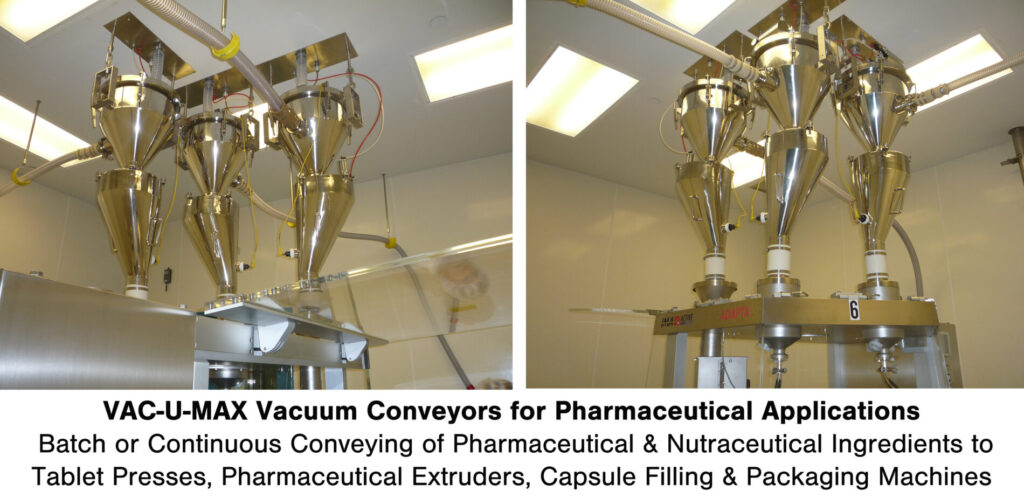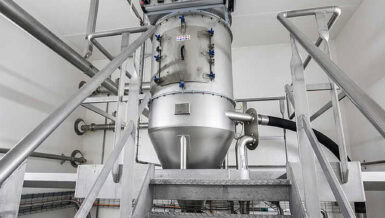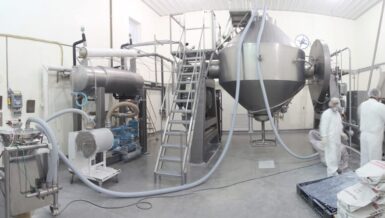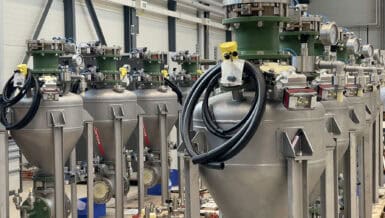Direct Charge Blender Loading: A Vacuum-Pressurized Approach
Direct Charge Blender Loading systems are designed for use with process vessels that are capable of withstanding vacuum, such as blenders. In this configuration, the process vessel itself becomes the primary receiving unit. Material is drawn directly into the vessel under vacuum, eliminating the need for a separate intermediate receiver.
This method is particularly beneficial for applications where minimizing dust exposure, spillage, and handling is critical. Since the material flows directly into the sealed process vessel, the system significantly reduces dust generation and cleanup requirements. Operators and manufacturing environments are not exposed to harmful or dusty materials, as transfer lines remain closed throughout the loading process. Additionally, Direct Charge Blender Loading systems are equipped with automated controls and filters that are pulse-cleaned, enabling reliable, hands-free operation between batches.
By removing the intermediate receiver and associated discharge step, Direct Charge Blender Loading Systems streamline the material transfer process, reduce downtime, and help ensure better batch-to-batch repeatability. However, it’s important to note that the process vessel must be structurally designed to withstand vacuum pressure.
Vacuum Conveying to Mixers: Flexible Integration Without Vessel Pressurization
In contrast, vacuum conveying to mixers utilizes a conventional vacuum receiver to transport dry bulk materials to the process without subjecting the mixer or downstream equipment to vacuum pressure. This approach is ideal for applications involving mixers or other vessels that are not vacuum rated, allowing for a wider range of equipment compatibility.
In this setup, material is conveyed from floor-level containers, such as drums, bags, totes, or bins, through enclosed tubing to a vacuum receiver. The receiver collects the material and then discharges it, typically via gravity, into the process vessel. While this introduces a transfer step between the receiver and the mixer, it offers greater flexibility for retrofitting into existing systems and for processes that require metering, weighing, or multiple material feeds.
This method still delivers many of the ergonomic, safety, and housekeeping benefits associated with vacuum conveying. Operators avoid lifting and manual dumping, dust exposure is minimized, and material transfer remains fully enclosed and automated. The use of pre-engineered components, including power sources, filters, controls, and receivers, allows VAC-U-MAX to customize systems based on material characteristics, throughput requirements, and process flow.
Choosing the Right Refill System for Your Process
The decision between Direct Charge Blender Loading and vacuum conveying to mixers depends on several factors, particularly whether the process vessel is vacuum rated. Direct Charge Blender Loading systems offer a more integrated, streamlined solution for vacuum-capable equipment, while conventional vacuum conveying provides versatility for a broader range of process configurations.
Both systems underscore VAC-U-MAX’s commitment to improving bulk material handling efficiency, operator safety, and material handling cleanliness through innovative pneumatic conveying solutions. Whether transferring powders, granules, or other dry bulk materials, VAC-U-MAX designs systems that meet the unique operational demands of manufacturers across a wide range of industries.
For more information or to discuss the best solution for your application, visit www.vac-u-max.com or call 1-800-VAC-U-MAX.













